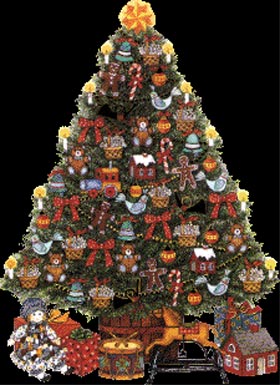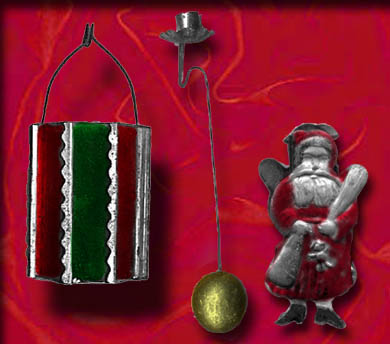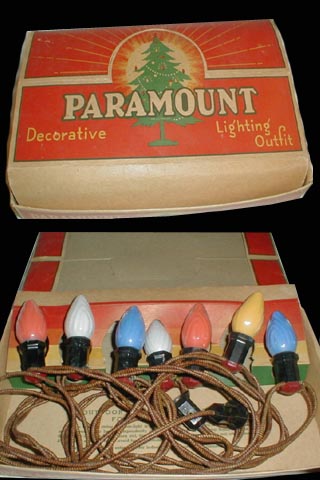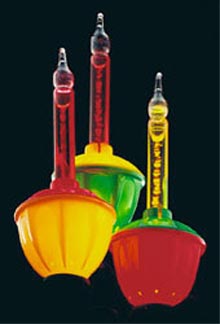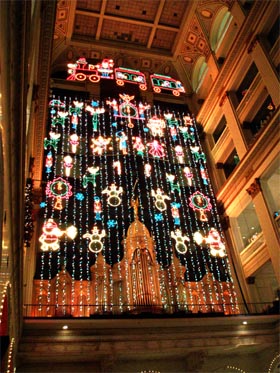pop up description layer
HOME
Cryptozoology UFO Mysteries Aviation Space & Time Dinosaurs Geology Archaeology Exploration 7 Wonders Surprising Science Troubled History Library Laboratory Attic Theater Store Index/Site Map Cyclorama
Search the Site: |
|
Christmas Electric: A History of Holiday Lights Today one can hardly find a street in North America during the month of December where the majority of houses are not lit up with a dazzling display of hundreds or even thousands of tiny electric lights. A few extreme homes may even have decorations that flash in sequence to the music of Trans-Siberian Orchestra or Mannheim Steamroller. Where did these traditions come from and when did Christmas become electric? The history of holiday lighting doesn't start with electricity at all. It starts with candles. Legend has it that Martin Luther, the Protestant church reformer, came up with the idea of placing lighted candles on a Yule tree. There's no real evidence for his, but we do know that around the middle of the 17th century the tradition of lighting the Yule tree with small candles started somewhere in Germany. Over the next 200 years the idea spread through that country and much of Eastern Europe. Originally, the candles were just attached to the tree by dripping hot wax on the branch and pressing the base of the candle on to it. Later, pins were used to secure the candles to the tree. In the mid-19th century, however, candle holders which were designed just for this purpose began to come onto the market. They came in three forms. Some were small lanterns designed to be hung from the branches (these could also be used for decorative lighting around or outside the home too). Others were clips that attached to branches and were molded in the shape of a holiday figure like Santa Claus. The last kind and perhaps the most unusual of the three was designed to hang from the tree's branches. Unlike the lanterns, however, these holders put the candle at the very top. To keep the candles upright, the devices used a long counterweight that hung under or to the side of the tree branch. Candle Troubles Though no doubt a tree lit with candles was a charming sight, but it was also dangerous. The open flames coming in contact with pine needles, especially on a dried-out tree, could easily generate a fire. For this reason most homeowners kept a bucket of water or sand near the tree to take care of such emergencies.
Candles were also inconvenient. They needed to be lit one by one and left drippings on the floor (at least until the invention of the "Christmas Rug" which sat under the tree to catch any errant drops of wax). As they were small, the candles could also be burnt only a short time and typically were not lit for an entire evening. This limited the enjoyment people got from them. In 1879 Thomas Edison's company built the first practical electric light bulb and the next year during the yule season Edison had his Menlo Park laboratory decorated with strings of electric lights. A couple of years later in 1882, Edward H. Johnson, vice-president of Edison's electric light company, opened his home to a reporter to show him a Christmas tree decorated with 80 electric bulbs. According to the story the reporter filed, the lights were encased in "dainty glass eggs and about equally divided between white, red and blue." The tree was on a box that turned and the lights alternated on and off. "It was a superb exhibition," proclaimed the article. In 1895 President Cleveland had an electrically lighted Christmas tree installed in the White House and soon electric lights in trees became popular with the well-to-do, the only people who could really afford such an extravagant display. Because electric light sets hadn't yet been invented yet, miniature bulbs would have to be purchased (or rented) from Edison's company and hand connected to the wires, a time-consuming effort that might cost hundreds of dollars and required the skills of an electrician. First Electric Sets General Electric was the first to market a light set in 1903. Referred to as "festoons," the 24-bulb set was priced at $12. While this might not seem too expensive today, the cost was still far out of reach of most ordinary people.
These early sets did not plug into a wall socket like ours do today. Houses in those days were wired only for lighting so the end of the string had to be in the shape of a screw-in light bulb base so that it could connect into an existing wall lamp or ceiling socket. To get around this problem, light sets that ran on batteries soon began to appear. An early set from the Excelsior Supply Company of Chicago boasted "No Smoke, No Dirt, No Grease, No Danger from Fire." Also "Candles are Dangerous. Electric Lights are Safe." Despite this claim, electric lights - especially those connected to house current - were not always perfectly safe. Worn wiring could spark a fire. Also, in some early sets the bulbs were wired in parallel with each bulb getting the full 110 house voltage. The early bulbs with this amount of power burned very hot and could potentially set a dry tree on fire. For this reason some companies introduced serially wired lights. Serial Light Strings Light sets wired in serial were generally cheaper to make as a single wire ran from light socket to light socket to make a full circuit. Because of this the 110 volts was divided among all the bulbs making each bulb burn cooler. Serial light sets, however, had one major disadvantage: If one burned out, it broke the circuit and the entire set went out. With all the lights out, the owner had little choice but to find a (hopefully) good spare bulb and work his way down the set, taking each bulb out and putting the spare in its place. If he found the bad bulb the set would re-light. Many an owner, however, went through an entire set without it coming back on, only to realize that the supposedly "good" spare bulb was, in fact itself, burned out. Checking a set by removing and testing every bulb was difficult, especially if the set was already on the tree, or even worse, outside on the roof on the house. For this reason, a number of manufacturers came up with schemes to address this problem. One solution was to eliminate the spare bulb for testing with a device the screwed into the socket and closed the circuit but did not light up. However, this still required that each bulb be removed until the burned out one was found. Another solution was a button at the base of each light socket that could be pressed to bypass the bulb. Each button could be pressed in turn until the set lit. The socket with the button that re-lit the set would contain the burned out bulb. Perhaps the most successful solution was a "shunt" that would automatically close when a bulb burned out keeping the circuit connected. This allowed the rest of the set to stay lit. However, because the voltage was now divided over a smaller number of bulbs, those that remained got a higher voltage and therefore had a shorter life span. The owner had to be alert to replace a burned out bulb quickly or the rest of the set would soon follow. The manufacture of Christmas lights virtually stopped during World War II, as many of the materials to build sets were needed for the war effort instead. Interest in Christmas lightning came back quickly after the end of the conflict in the late 40's, however. Manufacturers settled on several standard bulb types and most of the new sets ran in parallel as the new bulbs operated cooler even at 110 volts. Several novelty type lamps were invented, including the bubble light. Contests for the best decorated house became popular as increasingly lights were used not just on the Yule tree, but on the exterior of the family dwelling. Manufacturers, seeing an additional market to sell into, made sure that there were weatherproof models in their lighting sets.
Bubble Lights The bubble light was first introduced by a manufacturer named NOMA in 1946. The lamp was styled like a miniature candle holder and candle. The holder was made of translucent plastic and contained the light bulb. The candle itself was a hollow tube filled with a chemical that boiled at low temperature. When the light was switched on it would heat the base of the tube until the chemical boiled and was converted to gas. The gas bubbles would then float up the tube to the top where they would cool enough to change back to liquid so the process could start all over again. The bubblers were extremely popular and NOMA sold thousands and thousands of sets. Competing companies also picked up the idea and there were few Christmas trees of that era did not sport at least a few of these animated ornaments. Mini Lights Debue In the 1950's the first miniature lamp sets (sometimes referred to as fairy lamps or twinkle lights) were sold. These sets were originally produced in Italy, but soon were manufactured in many other countries including Germany, Holland and Japan, but never the United States. These sets were wired in series, using a shunt that closed automatically if a bulb burned out to keep the rest of the set lit. Because the sets contained many more bulbs that the earlier serial lamps sets and each bulb worked at a lower voltage, having one burn out did not quickly lead to the rest of the set burning out, fixing a major disadvantage of serial sets. These imported sets were made mostly of plastic. Though some early sets had screw-in bases for the bulbs, a simple plug in arrangement became the standard as it proved to be cheaper, simpler and just as reliable. These new miniature lights were inexpensive and could easily be mass produced. Eventually, almost all of the once popular screw-in parallel sets were replaced by serial plug-in miniature lights. Though many people were nostalgic for the older lights, the new lights allowed a homeowner to get much more lighting for the same amount of money. This led to larger and more extreme house Christmas displays than in years past.
Because the miniature lights were so widely produced, manufacturers needed to come up with variations in the sets that would attract new buyers by giving them an extra value. An example of these variations included "icicle lights" designed to hang from the house gutters. Another example is lighting nets where the bulbs were wired to a light-weight net making it much easier to cover a bush as compared to doing the same thing with a regular string. As electronics became miniaturized, some sets included the ability to flash with different patterns. A typical arrangement was a string acting as "chaser" lights that gave the illusion of the lights running down the string as the result of the bulbs being turned on and off in the right sequence. Houses Become Shows Complex Christmas lighting displays set to music had been a tradition at some commercial locations (like the famed Wanamaker show in Philadelphia) for decades, but with the cost of computers and electronics dropping the equipment needed to control such as show eventually became available to enthusiastic homeowners. In 2004 a home Christmas light show designed by Carson Williams from Mason, Ohio, became an internet viral video sensation. Williams had used a computer to control 88 channels of lights making them blink in time to the Trans-Siberian Orchestra's song Wizards of Winter. Williams continued his home displays until the traffic congestion in his neighborhood became a major problem. He discontinued the show in 2006, but started a business, Consar Lights, which now does light shows in commercial settings. William's example, however, showed people what could be done with a home display. With the price of a small 16 channel system at only $500 (without lights or a computer) almost anyone with a desire to could set up such a show. Interest in these display have been fueled by a new round of contests similar to those popular in the 1950's The next revolution in Christmas Lighting is now underway with LED lights, a spin-off of the computer revolution, replacing the incandescent bulbs that have been the mainstay of Christmas lighting since Edison first strung them up over a century ago. The LED (which stands for Light Emitting Diode) was invented back in the 1960's. However, early versions were expensive and could only produce red light. Unlike incandescent bulbs that produce white light that must be put though a filter or gel to produce a color, LEDs produce only a single shade of light. As all computer related silicon based electronic have gotten cheaper over the years so has the LED. The varieties of colors they can produce have also gotten wider. The hardest color to produce turned out to be blue which only became available in the late 1990's at a price that would allow them to be used on Christmas light strings.
Though the LED lights strings still have a higher initial cost that the incandescent bulbs, they are cheaper to run and have extremely long lives compared to traditional lighting sources. So what will holiday lighting look like in another hundred years? It is almost impossible to imagine what people will come up with to illuminate the season in the next century. We can only predict, that like Christmas lights always have, they will dazzle their viewers. Copyright Lee Krystek 2009. All Rights Reserved. |
|
Related Links |
|
|



